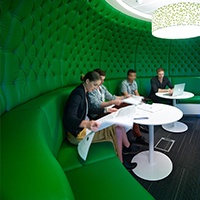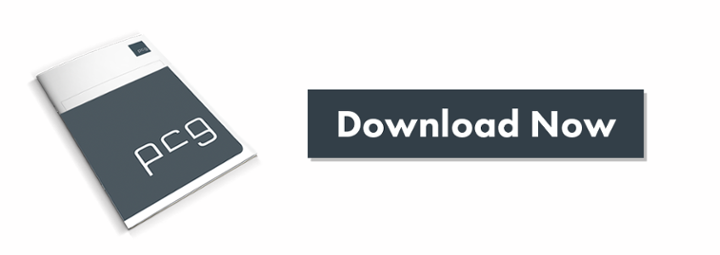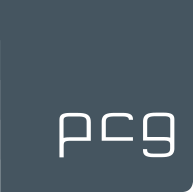Three areas your workplace design should focus on to stay competitive.
Trends in workplace design are changing, with a strong focus on creating workplaces which attract and retain the best talent. Employees now expect more from employers and with an emphasis upon attaining a work-life balance. Here are a few things organisations should consider when designing their workplace to stay competitive and therefore profitable.
 1. Employee Wellbeing and Engagement
1. Employee Wellbeing and Engagement
Employee Engagement
Worldwide, only 13% of employees working for an organisation are engaged.’ 1
(meaning they are involved in, enthusiastic about and committed to their work and workplace)
As employee engagement has a direct link to productivity and your bottom line, it’s not enough to simply conduct an employee satisfaction survey each year to determine where you might need to improve. ‘Companies often make decisions based on cost and proposed deliverables rather than on a close evaluation of the end-game deliverable of an improved workplace and performance.’2
Companies must introduce a top-down strategy for optimal employee engagement, have a clear communication strategy and continually evaluate and use the data gathered. Companies that have high employee engagement have made engagement part of their culture.
‘Engagement is the result of concrete performance management activities, such as clarifying work expectations, getting people what they need to do their work, providing development or promoting positive co-worker relationships.’3
PCG has seen some organisations go as far as to employ a Chief Experience Officer (CXO) to ensure their workplace offers engaging employee experiences.
Employee Well-being
In the coming years, employee well-being will also be a major focus for employers and many organisations are already implementing wellness programs. The key will be having a complete strategy in place, not just offering yoga classes for a few weeks a year. Measuring results and benefits against costs will also be a focus to firstly ensure employees are happy with the wellness program offerings and if there is any direct correlation between absenteeism and productivity levels.
The cost of absenteeism in Australia is estimated at $7 billion each year, while presenteeism — defined as not fully functioning at work because of a medical condition — was recently estimated to cost the economy more than $34 billion a year.4
In the past it’s been reported that the strongest programs were created in consultation with staff and created a culture of health, intertwining individual health promotion efforts with the overall company goals and objectives.
Another element of employee well-being will be linked to the actual office environment with a focus on air and water quality, and natural light available as these are said to affect staff both physically and mentally and can even affect productivity levels.
 2. Technology Ready
2. Technology Ready
The “Internet of Things” (IoT) is changing the way we work today and will continue to do so. In some existing workplaces, employees can control lighting and temperature or enter their building using facial recognition. Artificial Intelligence technology will automate mundane tasks such as booking meeting rooms and global offices will be connected using virtual reality devices. Read more on AI and office design >
An example of where technology in the workplace is heading is The Edge Building in Amsterdam, which is mostly occupied by Deloitte. It’s said to be the smartest building in the world and the greenest.
Some interesting facts about The Edge Building:
- The British rating agency BREEAM, gave it the highest sustainability score ever awarded with 98.4 percent.
- The building recognises your car and directs you to a car space
- A Smartphone app can check your schedule and locates a desk for you
- Wherever you are in the office the app knows your lighting and temperature preferences and adjusts them accordingly.
- The coffee machine even remembers how you like your coffee!5
 3. The Agile Workplace for the Agile Worker
3. The Agile Workplace for the Agile Worker
What is an agile workplace? Agile innovation methods came from software development companies but have now been widely adopted by a variety of industries and companies. The Harvard Business Review says agile methodologies ‘involve new values, principles, practices, and benefits and are a radical alternative to command-and-control-style management. By taking people out of their functional silos and putting them in self-managed and customer-focused multidisciplinary teams, the agile approach is not only accelerating profitable growth but also helping to create a new generation of skilled general managers.’6
The 10th Annual State of Agile™ Report shows that over the past five years, the top three benefits of implementing an agile approach are:
- An ability to manage changing priorities,
- Increased team productivity
- Improved product visibility.7
An agile working environment shouldn’t be confused with an Activity Based Work (ABW) environment.
Agile
- Focuses on the team’s needs and designing a workplace to meet those needs.
- Brings people from different teams together to increase productivity and reduce the time taken to assemble and disassemble project teams.
ABW
- Focuses on the individual’s workstyles and needs and creates multiple work settings for a variety of specific tasks.
- Optimises the use of available space.
From our experience, most organisations benefit from a tailored solution specific to their business needs and objectives. Which, in many instances, is a blend of a traditional and ABW or Agile workplace. Remember that true ABW workplaces represent less than 0.01 of Australian workplaces with most existing workplaces being either traditional or a hybrid of traditional and agile.
As technology continues to advance and views on what constitutes an ideal workplace change, companies taking employee well-being, technology and flexibility into consideration when designing their office should benefit from highly engaged employees resulting in higher productivity. A well-designed workplace will always take into consideration the future needs of the business and allow room for growth and or and change
If you would like any further information on these workplace predictions or workplace design, please don’t hesitate to contact PCG.
For more information on Activity Based Working (ABW) download our free whitepaper, 'The Genesis of Activity Based Working.'
Acknowledgements
1. Gallup 2016, ‘The Worldwide Employee Engagement Crisis.’ Viewed January 2018
2. Gallup 2016, ‘The Worldwide Employee Engagement Crisis.’ Viewed January 2018
3.Gallup 2016, ‘The Worldwide Employee Engagement Crisis.’ Viewed January 2018
4. ABC News 2016, ‘Workplace Wellness Programs – Do they Work?’ Viewed January 2018
5. Bloomberg 2015, ‘The Smartest Building in the World.’ Viewed January 2018
6.Harvard Business Review 2016, ‘Embracing Agile.’ Viewed January 2018.
7. Colliers Global Workplace Trends Report 2017, ‘Five Shifts Companies Must Make in the Next 5 Years.’ Viewed January 2018










Share your thoughts